
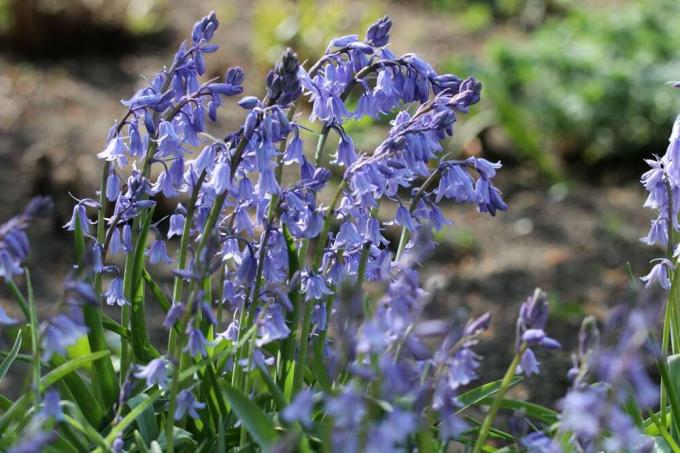
Table of contents
- Spanish bluebell
- Atlantic bluebell
- natural reserve
- toxicity
- heyday
- location and soil
- planting time
- planting
- onion division
- sowing
- Pour
- Fertilize
- Cut
- hibernate
- Diseases
- pests
A wintry gray garden needs a beautiful spring dress after its long sleep. Harebells, which have slumbered almost forgotten in the ground, are now making their grand appearance as designers. They go out onto the garden stage with a bright blue creation consisting of countless little flower bells. They are sure to get admiring looks. Do your part by delivering the right care.
Spanish bluebell
The Spanish bluebell, also called Spanish squill, comes from the Mediterranean region, more precisely from western Spain, Portugal and Northwest Africa. There it grows extensively and wildly on dry rocky slopes and also enriches green grassy meadows. In these climates, it is also used to occasional dry periods.
In the other regions, the Spanish bluebell, botanically Hyacinthoides hispanica, was deliberately settled as a garden plant because of its attractive appearance. There are now numerous hybrid varieties of this perennial plant. They form a clump as they grow and bloom white, pink or light blue.
Atlantic bluebell
Unlike the Spanish bluebell, its distribution area also extends to central and northern Europe. It is valued both as a cut flower and as an ornamental plant. But the wild stocks are also impressively large. Every spring, especially in Great Britain, they transform countless forest floors and parks into a sea of blue flowers for several weeks. This has given the Atlantic bluebell its second name "English bluebell". It is particularly suitable for planting in natural gardens, where it can grow and spread in peace. At the beginning, a few plants are enough, the rest is taken care of by time in interaction with nature.
natural reserve
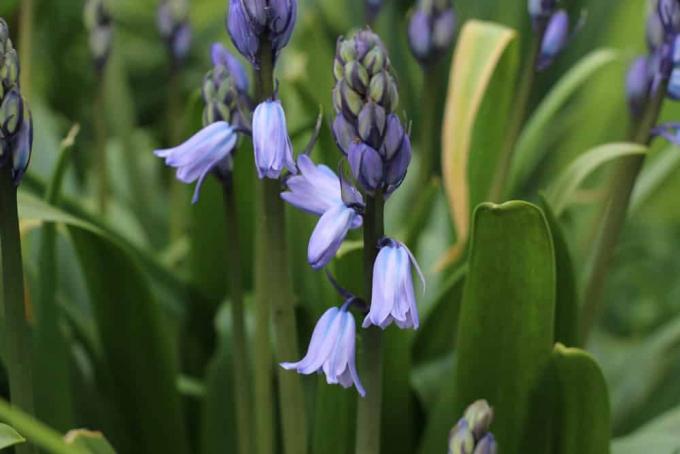
We often encounter bluebells in the wild, along hiking trails and under shady trees. The temptation is great to take some of the stems with you for the vase. But that's not allowed, even if it's just a few flower stalks out of a huge total. All specimens that grow wild in nature or in the garden are protected. This means that they may not be picked, removed or destroyed in any other way. You can only lend a hand if you have planted bluebells yourself.
toxicity
This innocent-looking plant harbors toxic substances such as saponins and cardiac glycosides in all its parts, but especially in the bulb and seeds. The latter have a negative effect on cardiac activity when ingested. This plant is listed as "slightly poisonous" overall. Their venom most commonly causes the following symptoms:
- nausea
- Malaise,
- Diarrhea
- Headache
- stomach pressure
- contact allergies
Contact allergies occur when there is direct skin contact with the plant sap. It comes to unpleasant itching and redness. All other symptoms are immediate bodily reactions when parts of this poisonous plant are consumed. Of course, no gardener will voluntarily put this plant in their mouths, but small children do occasionally. If this plant is to grace a family garden, education and awareness are imperative.
heyday
The two species of bluebell, the Atlantic bluebell and the Spanish bluebell bloom at different times. The Atlantic bluebell, also known as wild hyacinth, blooms first. Its delicate flowers are already open in April and exude a very light fragrance. The bell squill follows in May, with equally beautiful flowers that are unfortunately odorless. The beginning of the flowering period is also influenced by the current weather conditions. Once in bloom, both types flower for about two months.
location and soil
Finally a suitable flowering plant for those less popular spots in the garden: shady spots under trees and bushes where full sunlight rarely gets. Under these conditions, bluebells like to spread and add splashes of color where otherwise there would be more bare spots. The following applies to bluebells:
- they like half shade to shade
- like to grow under trees and bushes
- are suitable for shady rock gardens
- prefer moist and well-drained soils
- Humus content promotes their growth
- need enough space to spread out
- They don't like waterlogging at all
- a drainage layer under the bulbs protects them from rot
Tip:
Loamy soil in particular tends to become waterlogged. Loosen up such soil with a little sand before planting the bluebell bulbs so that rainwater can seep away better.
planting time

Bluebell bulbs are planted in the garden in autumn, from September to November. Planting should be done before the first frosts, after that no more planting, no matter what the calendar says. Hare bells are also ideal for a flower arrangement in a bucket. They flower after daffodils and hyacinths and can still delight with beautiful flowers after the other two types of plants have already faded.
planting
Bluebells are delicate plants that do not grow very tall. They almost always stay below 50 cm. When planted individually, they are less conspicuous and more likely to be overlooked. Several bluebells, on the other hand, form a carpet of flowers and can no longer disappear optically.
- Groups with several onions each are optimal
- Distance between individual tuffs should be about 12 cm
- Onions can also be planted in long rows
- Planting depth is 6-10 cm depending on the variety
- Onions need to be watered after planting
Tip:
Based on the bulb size, the planting hole should be two to three times deeper. Onions that are planted too deep do not sprout at all or sprout late. Therefore, when planting newly purchased varieties, pay attention to the exact information on the packaging.
onion division
It is typical for onion flowers that they take care of their offspring themselves. So does the rabbit bell. Every year many small onions form directly on the main onion. If the natural course is not interfered with, the bells will continue to spread on their own. That's a good thing, because the small plants come into their own much better in groups. If you want to decorate other places in the garden with it, you can plant the new onion shoots there. September and October are suitable months for transplanting.
- Wear gloves to avoid contact allergies
- Use a sharp and sanitized knife.
- Carefully dig up the flower bulb.
- Separate the daughter onions with the knife.
- Plant back the mother bulb.
- Plant the small bulbs in a suitable location.
- Pour in the onions.
- Spanish bluebells need to be planted 8-10 cm deep in the ground
- Atlantic bells, on the other hand, only need a depth of 6-8 cm
sowing
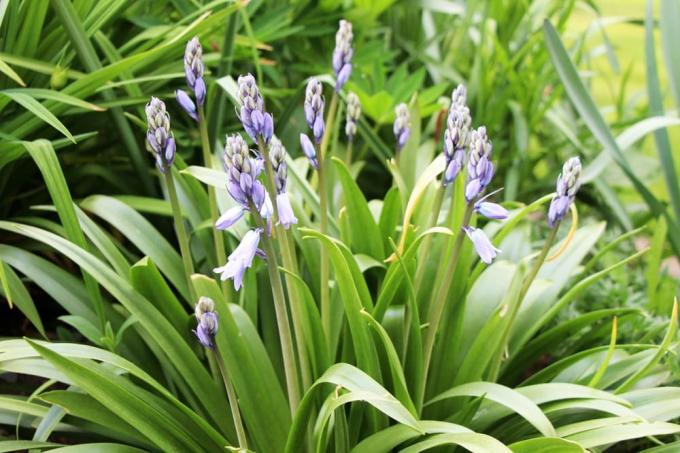
If spent flower stalks are left standing, the seed will mature within a few weeks. The seeds are so-called cold germs, which need cold temperatures to germinate. The inhibition of germination must be overcome with stratification. Since this is quite complex, this type of propagation is not so tempting. Another disadvantage is that the bluebell grown from seed takes several years to bloom. If you want to have that patience and try seed propagation, you can start with a warm-cold stratification in February or March.
- Sow the seed in seed compost.
- Place the pots in a warm room for two to four weeks.
- Keep the soil moist.
- Move to a cold location with temperatures of -4 to 5 degrees
- The small seedlings are planted out in May.
With a bit of luck, this procedure will lead to new bluebells. If the conditions are not optimal, germination can take much longer.
A notice:
The seeds are poisonous, do not leave them in the open air. Especially when they can get into the hands of children.
Pour
If the bluebell is planted in its preferred location, it hardly needs to be watered. Under trees and shrubs, where there is nice shade, the sun's rays hardly reach the soil and it therefore does not dry out as quickly. The rain is usually sufficient to cover the water demand. However, when the bluebell blooms, the soil should be checked for moisture from time to time. If the soil feels very dry, moderate watering is required. Use the soft rainwater from time to time to keep the lime content within limits. After flowering, when the bluebell retires, you no longer need to water.
Fertilize
The bluebell is extremely frugal when it comes to nutrients. Horn shavings provide it with nutrients evenly over a long period of time. This ensures healthy growth. During the flowering period from April, additional fertilizers can promote flower development. As soon as the flower has sprouted again in spring, you can spread some fine compost every two weeks.
Tip:
If you distribute the horn shavings early in the spring, this gives the microorganisms in the soil enough time to release some of the nutrients in time for the flowering period.
Cut
Reaching for the pruning shears can definitely be worthwhile for bluebells, as this gives the colorful splendor an extension of time in which new bells are formed. Since the bluebell is poisonous, wearing gloves is advisable.
- Remove faded flowers regularly
- Cut off any flower heads once flowering is over
- Cut off the yellowed and withered foliage close to the ground
- If necessary, cut flower stalks for the vase
Removing the flower heads will stop the sapping development of seeds. All the power can flow into the onion.
Tip:
If you want more bluebells in the garden, you can simply leave a few flower stalks. The mature seed sows itself.
hibernate
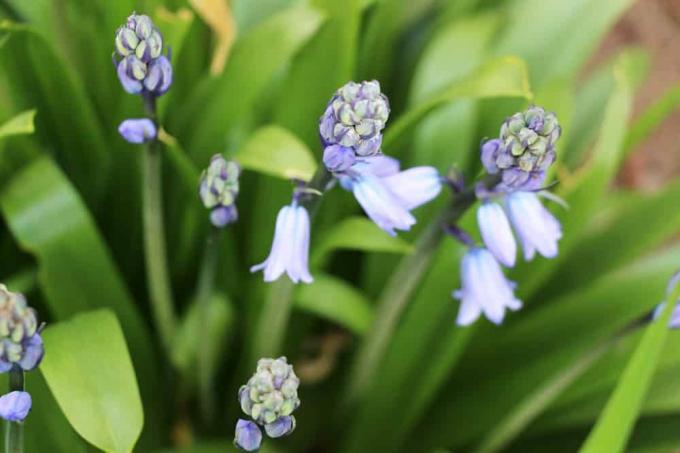
Hare bells for the garden are hardy and are well suited for overwintering outdoors. The bulbs remain in place, pull in their leaves and sprout again in the spring. In harsh winters, a light winter protection is still advisable as a preventive measure. Cover the bulbs of bluebells in good time before the first frost comes. The following applies:
- dry leaves falling from neighboring deciduous trees are a good layer of insulation
- Cut off fir branches can serve as a cover
- Protection must be removed in February or March.
Protected in this way, the bluebells sprout in large numbers in spring. Bluebells that are planted in tubs and pots should overwinter frost-free. These spring bloomers are best placed in suitable winter quarters immediately after pruning. It should be frost-free and not too dark. In the spring, the tubs can be placed outside again.
Diseases
Bluebell bulbs are resilient to disease. Just too much moisture makes them susceptible to fungal diseases and causes them to rot. When planting, make sure that the soil is well drained. Mix the soil with some sand to increase permeability. Also, be cautious when watering, this is the most effective way to prevent rot.
pests
Snails like to visit the leaves and flowers of the bluebell. The plant survives the attack because underground bulbs are spared and sprout again the next year. Nevertheless, eaten bluebells are not a pretty sight. Always keep an eye out for snails and act quickly as soon as you spot the first slimy creatures. In this way, the snail plague cannot cause any major damage and also does not get the opportunity to lay countless snail eggs for the next year.
If your garden is inhabited by voles, sooner or later they will attack the bulbs. Prevent by planting the bulbs together with fine-mesh metal trellis baskets. In this way, the attracted mice are left out.
 garden editorial
garden editorial I write about everything that interests me in my garden.
Learn more about flower bulbs
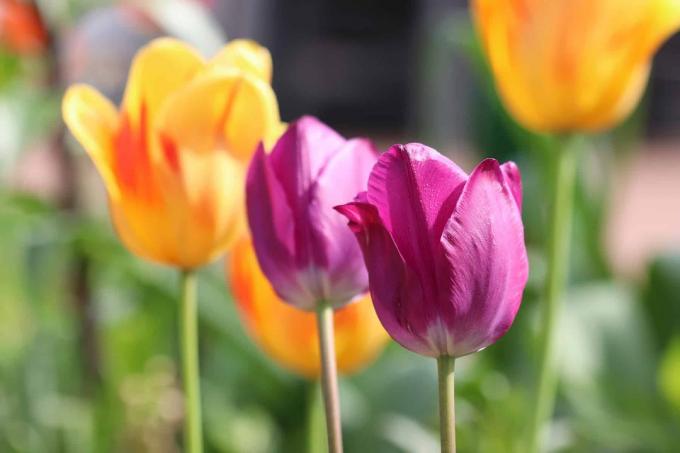
Tulips do not bloom and only put out leaves: what to do?
Tulips are among the most popular spring bloomers. They are therefore extremely common in domestic gardens. However, various causes can lead to the onion plants only developing leaves and no flowers. You can find out what to do in this case here.

Madonna lily, Lilium candidum: 9 care tips
Due to its growth height of more than one meter and the imposing white funnel-shaped flowers, the Madonna lily is one of the most impressive native bulbous plants. What to look out for when caring for this impressive flower is summarized in 9 clear care tips.

Daylilies, Hemerocallis: care from A – Z
Daylilies (Hemerocallis) are among the loveliest and most rewarding flowering perennials. Even if each individual blossom lasts only one day, countless new blossoms form again and again and decorate the garden for weeks. In addition, they are available in almost every color imaginable.

Freesia, Freesia: care tips from A - Z
Freesias are popular summer plants because they are colorful and have a pleasant, delicate scent. The irises, originally from Africa, are not difficult to care for, but do not tolerate frost. You can easily propagate the freesias yourself using the bulbs.

Milk Star, Ornithogalum: care from A to Z
The Orange Milk Star (Ornithogalum dubium) is a popular ornamental plant from the Cape Province. Because of its decorative flowers, it is often used as a cut flower in flower arrangements. The ornamental plants are undemanding, but should be cared for with caution due to their toxicity.

Checkered flower: care from A to Z | Instructions
The checkered flower (Fritillaria meleagris) attracts everyone's attention with its bell-shaped flowers. The reason for this is their striking pattern, which is strongly reminiscent of a chessboard. This striking check pattern shows the bulb flower in different shades.

